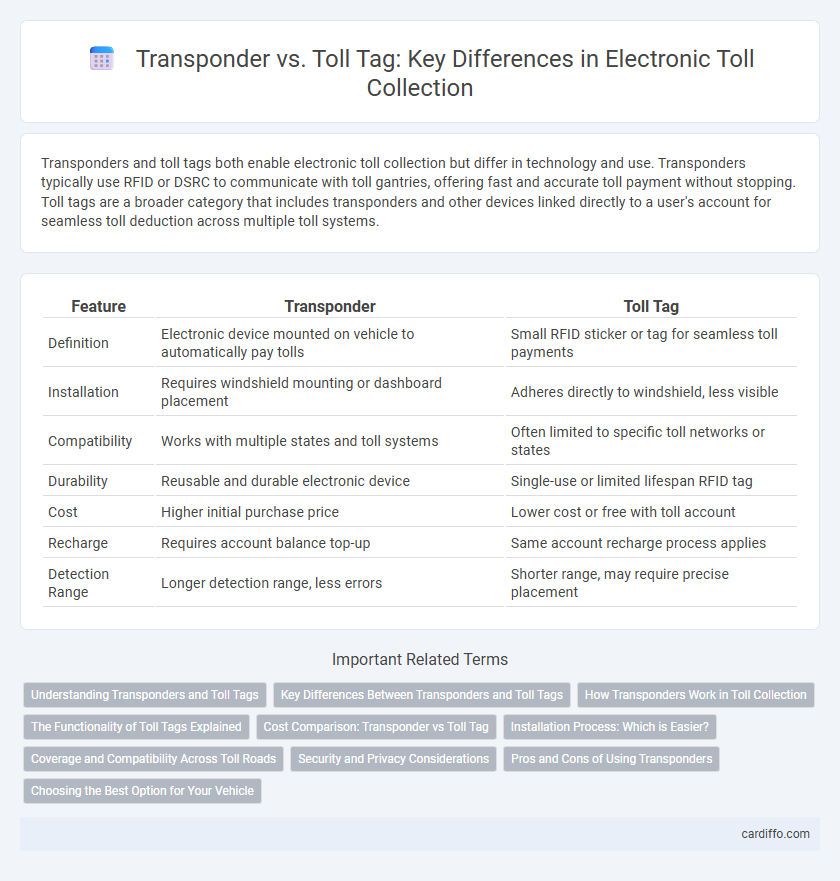Transponders and toll tags both enable electronic toll collection but differ in technology and use. Transponders typically use RFID or DSRC to communicate with toll gantries, offering fast and accurate toll payment without stopping. Toll tags are a broader category that includes transponders and other devices linked directly to a user's account for seamless toll deduction across multiple toll systems.
Table of Comparison
| Feature | Transponder | Toll Tag |
|---|---|---|
| Definition | Electronic device mounted on vehicle to automatically pay tolls | Small RFID sticker or tag for seamless toll payments |
| Installation | Requires windshield mounting or dashboard placement | Adheres directly to windshield, less visible |
| Compatibility | Works with multiple states and toll systems | Often limited to specific toll networks or states |
| Durability | Reusable and durable electronic device | Single-use or limited lifespan RFID tag |
| Cost | Higher initial purchase price | Lower cost or free with toll account |
| Recharge | Requires account balance top-up | Same account recharge process applies |
| Detection Range | Longer detection range, less errors | Shorter range, may require precise placement |
Understanding Transponders and Toll Tags
Transponders and toll tags are electronic devices used to facilitate automated toll payments on highways and bridges, enhancing convenience and reducing traffic congestion. Transponders typically communicate via radio frequency identification (RFID) technology to transmit vehicle information to toll collection systems, enabling seamless toll deduction from linked accounts. Toll tags function similarly but often vary by regional systems, supporting interoperability in multiple toll networks and providing users with real-time toll tracking and account management features.
Key Differences Between Transponders and Toll Tags
Transponders and toll tags serve the same primary purpose of enabling electronic toll collection but differ in technology and compatibility. Transponders typically use radio-frequency identification (RFID) to communicate with toll gantries, offering faster processing and wider interoperability across states. Toll tags often refer to specific branded devices linked to regional toll authorities, which may have usage restrictions and limited acceptance beyond designated areas.
How Transponders Work in Toll Collection
Transponders use radio-frequency identification (RFID) technology to communicate with toll plaza systems, enabling automatic vehicle identification and seamless toll payments. When a vehicle with a transponder passes under the toll gantry, the device emits a unique signal that registers the toll transaction in real-time, eliminating the need for stopping or manual payment. This system enhances traffic flow efficiency and reduces congestion on toll roads by enabling rapid, contactless toll collection.
The Functionality of Toll Tags Explained
Toll tags function through RFID technology, allowing vehicles to pass toll booths without stopping by automatically transmitting account information for seamless payment. Unlike generic transponders that may have broader applications, toll tags are specifically programmed to interact with tolling systems, ensuring accurate toll collection and account management. This targeted functionality enhances traffic flow efficiency and reduces congestion at toll plazas.
Cost Comparison: Transponder vs Toll Tag
Transponders typically have a higher initial cost but offer long-term savings through reduced toll rates and wider acceptance across multiple toll systems. Toll tags often come with lower upfront fees but may include additional service charges or limited interoperability, potentially increasing overall expenses. Evaluating the total cost of ownership, including device fees, account maintenance, and toll discounts, is essential for an accurate cost comparison between transponders and toll tags.
Installation Process: Which is Easier?
Transponder installation typically requires mounting the device inside the vehicle, often on the windshield, following manufacturer guidelines for optimal signal detection. Toll tags usually come with adhesive backing or clip options, allowing for quicker and simpler self-installation without professional assistance. Ease of installation favors toll tags due to their user-friendly setup and minimal steps compared to some transponder models that may demand precise placement or technical calibration.
Coverage and Compatibility Across Toll Roads
Transponders typically offer broader coverage and compatibility across various toll roads nationwide due to their integration with multiple electronic toll collection systems. Toll tags, while often limited to specific regions or toll authorities, excel in seamless use within their designated areas, ensuring accurate and efficient toll processing. Choosing a solution depends on travel frequency across multiple states versus localized toll road usage, with transponders favoring multi-state convenience and toll tags optimized for regional compatibility.
Security and Privacy Considerations
Transponders and toll tags both facilitate electronic toll collection but differ significantly in security and privacy measures. Transponders often use encrypted communication protocols to protect user data from interception, while some toll tags may have weaker encryption, increasing vulnerability to unauthorized tracking. Choosing a device with strong encryption standards and data anonymization features is crucial to safeguarding personal information during toll transactions.
Pros and Cons of Using Transponders
Transponders offer reliable electronic toll collection by communicating directly with toll plaza systems, enabling quick and automatic payment without stopping. They provide convenience and reduce traffic congestion but require an initial purchase and activation process, which can be a downside for infrequent users. Battery life and device compatibility with various toll networks may also impact usability and long-term costs.
Choosing the Best Option for Your Vehicle
Choosing between a transponder and a toll tag depends on the specific toll systems and coverage areas for your vehicle. Transponders often offer compatibility across multiple states and private toll roads, while toll tags provide streamlined access within regional networks. Evaluating factors such as travel frequency, geographic range, and cost helps determine the best option for efficient toll payment.
Transponder vs Toll Tag Infographic

 cardiffo.com
cardiffo.com